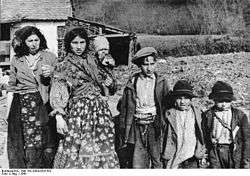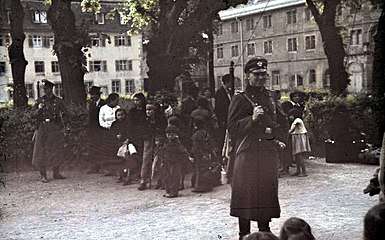Sinti
The Sinti (also Sinta or Sinte; masc. sing. Sinto; fem. sing. Sintesa) are a Romani tribe in Central Europe.[1] They were traditionally itinerant, but today only a small percentage of Sinti remain unsettled. In earlier times, they frequently lived on the outskirts of communities. The Sinti of Central Europe are closely related to the group known as Manouche in France. They speak the Sinti-Manouche variety of Romani, which exhibits strong German influence.
| Part of a series on |
| Romani people |
|---|
|
Diaspora
|
|

Name
The origin of the name Sinti is disputed.
Some, including many Sinti themselves, believe it derives from Sindhi, the name of a people of Sindh (a region in Pakistan), based on indications that Romani peoples originated in the Indian subcontinent.[2][3] In addition to the documented linguistic connections between Romani language and Sanskrit, a recent study by Estonian and Indian researchers found genetic similarities between European Romani men and Indian men in their sample.[4]
Others, including scholar Yaron Matras, argue that "Sinti" is a later term in use by the Sinti from only the 18th century on, and is likely a European loanword.[2][5]
History
The Sinti arrived in Germany and Austria in the Late Middle Ages as part of the Romani emigration from the Indian Subcontinent,[6] eventually splitting into two groups: Eftavagarja ("the Seven Caravans") and Estraxarja ("from Austria").[7] They arrived in Germany before 1540.[8] The two groups expanded, the Eftavagarja into France, Portugal and Brazil, where they are called "Manouches", and the Estraxarja into Italy and Central Europe, mainly what are now Croatia, Slovenia, Hungary, Romania, the Czech Republic and Slovakia, eventually adopting various regional names. In Italy they are present mainly in Piedmont region (where in Piedmontese they are called Sinto, although the word for Romani people is sìngher, as the Italian zingari), with some communities in Veneto and Emilia Romagna as well.
The Holocaust

The Sinti and other Romani migrated to Germany in the late 15th century. Despite their long presence, they were still generally regarded as beggars and thieves, and, by 1899, the police kept a central register on Romani people. The National Socialists considered them racially inferior (see Nazism and race), and persecuted them throughout Germany during the Nazi period—the Nuremberg Laws of 1935 often being interpreted to apply to them as well as the Jews.
Adolf Eichmann recommended that the Third Reich solve the "Gypsy Question" simultaneously with the Jewish Question, resulting in the deportation of the Sinti to clear room to build homes for ethnic Germans.[9] Some were sent to Poland, or elsewhere (including some deported to Yugoslavia by the Hamburg Police in 1939[10]) others were confined to designated areas, and many were eventually murdered in gas chambers.[11] Many Sinti and Roma were taken to Auschwitz-Birkenau, where they were put in a special section, called the "gypsy camp". Dr. Josef Mengele often performed some of his infamous experiments on Sinti and Roma. On August 2, 1944, the "gypsy camp" was closed, and approximately 4,000 Sinti and Roma were gassed during the night of August 2–3 and burnt in the crematoria. August 2 is now commemorated as Roma and Sinti Holocaust Remembrance Day.

In concentration camps, the Sinti were forced to wear either a black triangle, indicating their classification as "asocial",[12] or a brown triangle, specifically reserved for Romani people.
 Deportation of Sinti and Roma in Asperg, 22 May 1940
Deportation of Sinti and Roma in Asperg, 22 May 1940- Memorial for murdered Sinti in Düsseldorf-Lierenfeld
 Ravensburg, Memorial for Sinti murdered in Auschwitz
Ravensburg, Memorial for Sinti murdered in Auschwitz
Notable Sinti
There are a number of Sinti notable for their contributions in music. Django Reinhardt was a guitarist who fused traditional dance hall musettes with American jazz in 1930s and 1940s. Along with Stéphane Grappelli and other members of the Quintette du Hot Club de France, he founded the style of music known as Gypsy jazz.
Other notable Sinti musicians include Schnuckenack Reinhardt, Drafi Deutscher, and the jazz guitarists Jimmy Rosenberg and Paulus Schäfer. The Sinto Häns'che Weiss produced a record in Germany in the 1970s in which he sang about the Poraimos (Romani Holocaust) in his own language. Many younger Germans first learned about this part of Holocaust history as a result of this recording. Titi Winterstein and several members of Reinhardt's clan still play traditional and modern Gypsy jazz. The jazz keyboardist Joe Zawinul was also of Sinti descent.
Marianne Rosenberg is a successful Sinti/Roma-German singer. She is the daughter of Auschwitz survivor Otto Rosenberg, who in 1936, at nine years of age was placed in a concentration camp where his father, his grandmother, and all his siblings were murdered. She sings mainly in German but has sung in English, French, Italian, and the Sinti language. She finished tenth in the German preselection for the 1975 Eurovision song contest with "Er gehört zu mir". Her biography Kokolores is a bestseller in Europe.
Sinti are also notable for sporting achievements. Johann Trollmann won the 1933 light-heavyweight boxing championship of Germany but was stripped of the title by the Nazis, who could not tolerate a "non-Aryan" champion. Trollman was murdered in a concentration camp in 1943 by another inmate.[13]
List of notable Sinti
- Carlo Karges, musician
- Oto Pestner (b. 1956), Slovenian singer of swing, jazz, Slovenian folk music, gospel, best known for singing with the group New Swing Quartet.[14]
- Manitas de Plata, musician
- Django Reinhardt, musician
- Schnuckenack Reinhardt, musician
- Jimmy Rosenberg, musician
- Marianne Rosenberg, musician and daughter of Otto Rosenberg
- Otto Rosenberg (1927–2001), Holocaust survivor, author of A Gypsy in Auschwitz (1999), activist, and founder of Sinti Union of Berlin and Organization for German Sinti and Roma.[15][16]
- Paulus Schäfer, musician
- Johann Trollmann, boxer
- Häns'che Weiss, musician
- Joe Zawinul, musician
See also
- History of the Romani people
- Romani people by country
- Sindhi diaspora
- Sinte Romani (language)
References
- Martha Verdorfer: Sinti & Roma (in German)
- Yaron Matras, "The Role of Language in Mystifying and Demystifying Gypsy Identity" in: Nicholas Saul, Susan Tebbutt, The Role of the Romanies: Images and Counter-images of "Gypsies"/Romanies in European Cultures, Liverpool University Press (2004), ISBN 978-0-85323-679-5, p. 70.
- Kochanowski, Jan (1968). Lisa Pasternak Slater (translator). "Black Gypsies, White Gypsies: The Gypsies Within the Perspective of Indo-European Migrations". Diogenes. 16 (63): 27–47. doi:10.1177/039219216801606302.
- Nelson, Dean (3 December 2012). "European Roma descended from Indian 'untouchables', genetic study shows". Telegraph.co.uk. Retrieved 15 December 2017.
- Gypsies in Germany—German Gypsies? Identity and Politics of Sinti and Roma in German (PDF). 2007.
- "Europe invented 'gypsies,' says German author". Deutsche Welle. Retrieved 15 March 2014.
- Innsbrucker Beiträge zur Kulturwissenschaft: Sonderheft. 1993. ISBN 9783851241655.
- Nicholas Saul, Susan Tebbutt, p. 182
- Burleigh, The Racial State, p. 122.
- Michael Burleigh and Wolfgang Wipperman, The Racial State: Germany 1933–1945 (Cambridge, England: Cambridge University Press, 2002), 117.
- Davis, Mark (5 May 2015). "How World War II shaped modern Germany". euronews.
- Shapiro, Paul A.; Ehrenreich, Robert M. (2002). "brown+triangle"#search_anchor Roma and Sinti: under-studied victims of Nazism: symposium proceedings. Center for Advanced Holocaust Studies, United States Holocaust Memorial Museum. p. 24. Retrieved 2010-06-26.
- "A Fight for Memory –Monument Honors Sinti Boxer Murdered by the Nazis". Der Spiegel International. 30 June 2010. Retrieved 26 February 2011.
- New Swing Quartet.
- Contemporary Authors Online (Biography in Context). Gale. 2003. ISBN 978-0-7876-3995-2. Retrieved 29 March 2019.
- Pace, Eric (1 July 2001). "Otto Rosenberg, 74, Gypsy Who Survived Auschwitz". Obituaries. The New York Times. p. B9.
Bibliography
- Susan Tebbutt, Nicholas Saul; Tebbutt, Susan (2004). The role of the Romanies : images and counter-images of 'Gypsies'/Romanies in European cultures. Liverpool: Liverpool Univ. Press. ISBN 9780853236795.
Further reading
- Walter Winter, Struan Robertson (translator). Winter Time: Memoirs of a German Who Survived Auschwitz. Hertfordshire Publications, (2004), ISBN 1-902806-38-7.
- Reviewed by Emma Brockes "We had the same pain" in The Guardian November 29, 2004.
Sinti and Roma: Gypsies in German-speaking Society and Literature
Sinti and Roma: Legal Status and Perspectives for a European Minority
Roma in Europe: The Politics of Collective Identity Formation
External links
| Wikimedia Commons has media related to Sinti people. |
- Non-Jewish Victims of Persecution in Nazi Germany on the Yad Vashem website
- Wege nach Ravensbrück (Ravensbrück concentration camp: Memories of surviving female Sinti) (in German)
- F. N. Finck, Lehrbuch des Dialekts der deutschen Zigeuner (1903) on Internet Archive (in German)